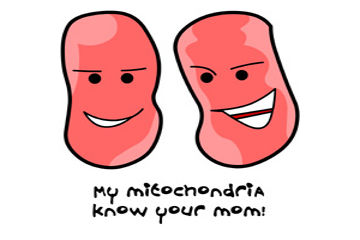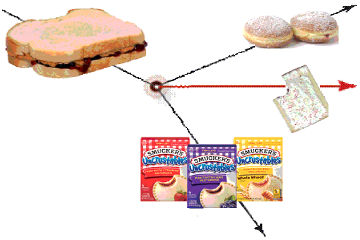What I’ve Learned:
“Mitochondrial Eve: Making DNA from an ooooooold family recipe.”
Imagine your DNA is a brown bag lunch. Your parents packed it with everything you need. A banana, if you like those. PB&J, maybe — unless your particular DNA makes you allergic to peanuts, in which case, I don’t know. Pizza? Fish heads? Who am I, Andrew freaking Zimmern?
The point is, your DNA comes from both your parents, in more or less equal amounts, and it’s stored in each of your body’s cells in something called a nucleus. That’s the bag in this analogy. Or the kick-ass Tardis lunch box, if you prefer.
Anyway, as she often does, your mother left you a little something extra.
But instead of a “love you” note or an extra Twinkie, our moms gave us something else: a bonus stretch of DNA, passed down only from mothers to children. This DNA is housed in a separate subcellular sack called a mitochondrion. Mitochondria do some pretty amazing things, but that’s a whole other bucket of lunches, so let’s stick to the DNA.
Because mitochondrial DNA is passed straight from mother to child, it can be traced back to earlier generations. Variations in DNA occur at a steady rate, and these get passed down, too. By comparing mitochondrial sequences between individuals, scientists can estimate how closely related they are — the more variations they share, the closer they are. If their DNA variations don’t overlap, it indicates they’re swinging on different branches of the old family tree. When a branch diverges enough to represent a unique DNA signature, it’s called a “haplotype” — a pattern of DNA variation shared by all the members of that branch.
Back in the 1980s, scientists tested mitochondrial DNA from more than one hundred people from different populations and found something unexpected: the variations between subjects suggested that they were all related, anthropologically speaking, by a common female ancestor who’d passed her mitochondrial DNA down the line. The research suggested that everyone in the entire human race shares the same great-great-great-lots-and-lots-more-greats grandmother. And we’re all rocking gently-used, slightly-mutated versions of her mitochondrial DNA.
This ancestral individual is technically called our matrilinear most recent common ancestor, or MRCA, but is more informally known as “mitochondrial Eve”; her maternal genetic makeup is represented in all of our DNA. She’s also been described as the “lucky mother”, since she wasn’t the only woman walking around and having babies at the time. Rather, her lineage — including mothers having daughters, since mitochondrial DNA is only passed by mothers, remember — is unbroken through history, while other childbearing ladies of the time had only sons, or no children, or their daughters didn’t produce more daughters down the line.
The idea of mitochondrial Eve shook science to its lunchtime Twinkies, because it implies a couple of things about human history. First, there was a time (or several) when our population must have been very small, maybe on the verge of extinction. For only one woman’s genetic imprint to have survived, rather than many, suggests there weren’t a whole bunch of humans running around the planet already, with haplotypes of their own. Our species went through some rough times, and only one branch of the tree survived.
The DNA also tells us roughly when this mitochondrial Eve existed. Based on the variability between contemporary humans’ DNA and the rate at which DNA glitches occur, mitochondrial Eve probably lived around 100,000 to 150,000 years ago. And since other evidence suggests that early humans didn’t migrate from Africa until about 95,000 years ago, our ur-granny most likely lived there. And cooked up some nice bits of DNA we’re still using today.
(For the record, we can also trace an “ultimate grandpa” via male lineages and the men-only Y chromosome. The “Y-chromosome Adam” may have lived around the same time as, or tens of thousands of years before, mitochondrial Eve. Their DNA’s early paths are completely independent.)
So next time you’re eating a sack lunch, root around in the bottom a little. Not only might you find a nice note — or a delicious snack cake — but you might discover some 100,000-year-old genetic material, courtesy of mitochondrial Eve. DNA appetit.




